Landmine Monitor 2016
Contamination & Clearance
States and other areas with antipersonnel mine contamination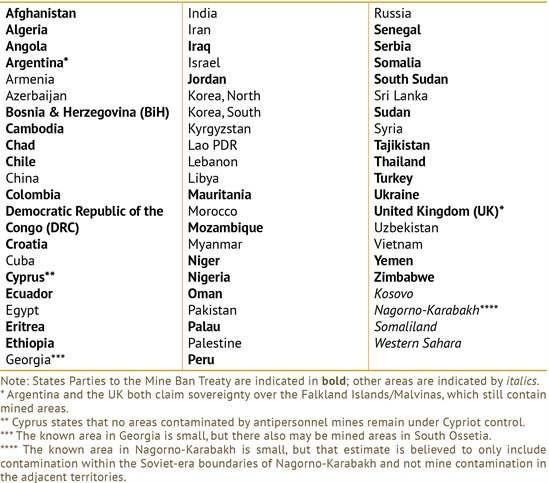
Six States Parties have residual or suspected contamination: Cameroon, Djibouti, Moldova, Namibia, the Philippines, and Tunisia.
Status and Key Developments 2015–2016[1]
- Sixty-four states and areas have an identified threat of antipersonnel mine contamination: 36 States Parties, 24 states not party, and four other areas. This is an increase from 61 states and areas in 2015, as Palau has been added to the list, and Mozambique and Nigeria returned to it. A further six States Parties have either suspected or residual mine contamination
- A total of 171km2 was reported to be cleared of landmines in 2015, a decrease from an estimated 201km2 in 2014. The total number of antipersonnel mines reported to be destroyed was just more than 156,000, a decrease from 232,000 in 2014.
- Twenty-six States Parties have completed implementation of Article 5 since 1999.[2]
- In 2015, five States Parties submitted extensions that were granted at the Fourteenth Meeting of States Parties: Cyprus, Ethiopia, Mauritania, Niger, and Senegal. Two states requested extended deadlines in 2016: Niger and Peru.
- Ukraine is in violation of Article 5 due to missing its 1 June 2016 clearance deadline without having been granted an extension.
- Jordan, Mozambique, and Nigeria should declare that they have obligations under Article 5 and request a new deadline to complete clearance.
- Only four States Parties appear to be on track to meet their Article 5 clearance deadline: Algeria, Chile, Democratic Republic of the Congo (DRC), and Ecuador.
Mine Contamination in 2015
It is not possible to provide a global estimate of the total area contaminated by landmines due to a lack of data. The understanding of the scale of the problem is generally improving, however, particularly among States Parties as countries make increased use of land release methodologies to cancel suspected hazardous areas by non-technical survey, and reduce confirmed hazardous areas through technical survey. However, in some states the extent of mine contamination became less clear in 2015 and 2016 due to reports of new contamination. There was new contamination in 2015 and/or 2016 in States Parties Afghanistan, Colombia, Iraq, Nigeria, Ukraine, and Yemen; and states not party North Korea, Libya, Myanmar, Pakistan, and Syria. There are also reports and allegations of new contamination in States Parties Cameroon, Chad, Niger, Philippines, South Sudan, and Tunisia; and in states not party Egypt and Iran.
Nigeria returned to the list of contaminated states as a result of reports of new contamination. Mozambique also returned to the list because of the discovery of pre-existing contamination. However, both states have yet to make a formal declaration of Article 5 obligations. Palau was added to the list as World War II-era emplaced antipersonnel mines were found and destroyed in 2015. Palau needs to confirm if it has any further antipersonnel contamination.[3]
No estimate of the size of contamination exists for eight States Parties, 18 states not party, and one other area, which are known to be contaminated.[4]
The table below is based on information provided by states. Some states currently report exceedingly large suspected hazardous areas. Over time, as they develop a more accurate understanding through survey, the category into which the state has been placed may change.
Estimated extent of mine contamination at end of 2015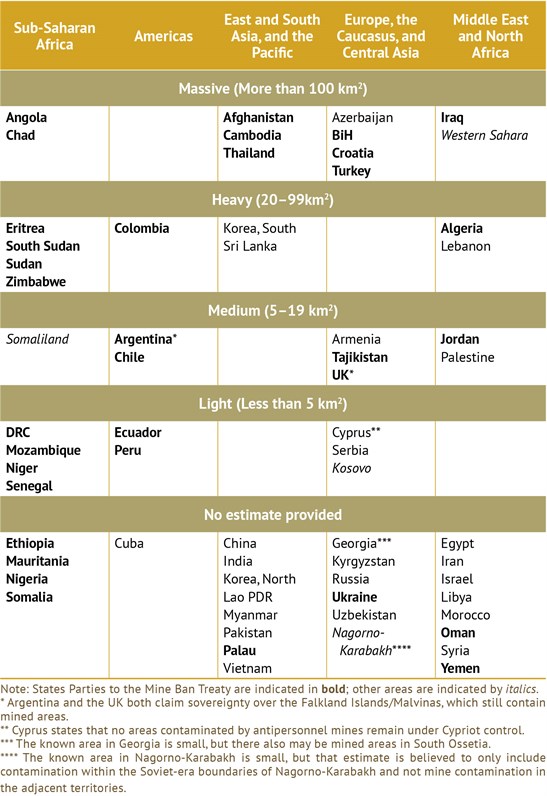
Six States Parties have residual or suspected contamination: Cameroon[5], Djibouti,[6] Moldova,[7] Namibia,[8] the Philippines,[9] and Tunisia.[10] These states have an obligation to make “every effort” to identify mined areas under their jurisdiction or control that contain antipersonnel mines and then to clear any that they find. They must report publicly on any contamination and on clearance efforts. In cases where they are unable to complete clearance within their Article 5 deadline, they must request an extension in order to remain in compliance with the treaty.
Mine Clearance in 2015
Total global clearance of landmines in 2015 was estimated to be 171km2, with just more than 156,000 antipersonnel mines destroyed. This represents a decrease from 201km2 of total area cleared in 2014 and a decrease from the destruction of approximately 232,000 antipersonnel mines.
Programs clearing the largest amount of mined area in 2015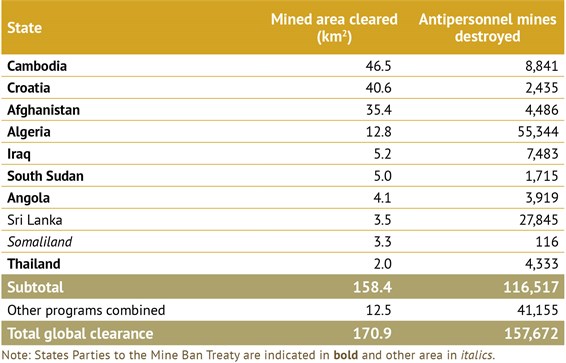
Four of the 10 most contaminated states (Azerbaijan, BiH, Chad, and Turkey) are not among those that cleared the largest amount of mined area in 2015, but instead are accounted for in “other programs combined” along with other states. No mine clearance was conducted in State Party Turkey in 2015, although 1,531 antipersonnel mines were destroyed “due to explosions caused by various reasons.”[11] States Parties BiH and Chad and state not party Azerbaijan reported low rates of clearance, between 0.26km2 and 1.64km2 each.
No mine clearance or survey occurred in States Parties Ethiopia, Turkey, Senegal, and Yemen;[12] and in states not party Cuba, Georgia, and Kyrgyzstan. No data was available for survey and clearance results in States Parties Eritrea, Nigeria, and Ukraine; and states not party China, Egypt, India, Iran, Libya, Morocco, Myanmar, North Korea, Pakistan, Syria, and Uzbekistan.
Mine clearance in 2011–2015 (km2)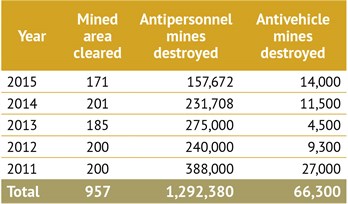
Under Article 5 of the Mine Ban Treaty, States Parties are required to clear all antipersonnel mines as soon as possible, but not later than 10 years after becoming party to the treaty. States Parties that consider themselves unable to complete their mine clearance obligations within the deadline may submit a request for a deadline extension of up to 10 years.
Completion of Article 5 implementation
Twenty-six States Parties, one state not party, and one other area have completed clearance since the treaty entered into force in 1999.
States Parties that have completed Article 5 implementation since 1999
In addition, state not party Nepal and other area Taiwan have completed clearance of known mined areas since 1999. El Salvador, a State Party, completed clearance in 1994, before the Mine Ban Treaty was created.
Both Jordan[13] and Mozambique[14] have declared completion of clearance under the Mine Ban Treaty (in 2012 and 2015 respectively), but they are still finding antipersonnel mine contamination and therefore do not appear in the table above. Nigeria[15] declared completion of clearance in 2011, however there have been reports of new contamination resulting from recent use of antipersonnel mines, including victim-activated improvised explosive devices (also called improvised mines) by a non-state armed group. It therefore does not appear in the table above.
Progress on meeting deadlines
As of October 2016, only four States Parties are on track to meet their clearance deadlines, while 18 are not on track, and the status of six is unclear. Two States Parties are awaiting approval of their extension requests submitted in 2016. One State Party has missed its deadline and is in violation of the treaty. Three States Parties that have declared completion in the past are still finding antipersonnel mine contamination and should request new deadlines.
The assessments of the status of each State Party regarding the fulfilment of Article 5 obligations are made through consideration of several factors, including the deadline date, the remaining challenge and the extent to which it is known, clearance rates, mine action capacity and assets, funding prospects, and the existence of any conflict and insecurity problems.
States Parties with antipersonnel mine contamination, their deadlines, and status of any deadline extensions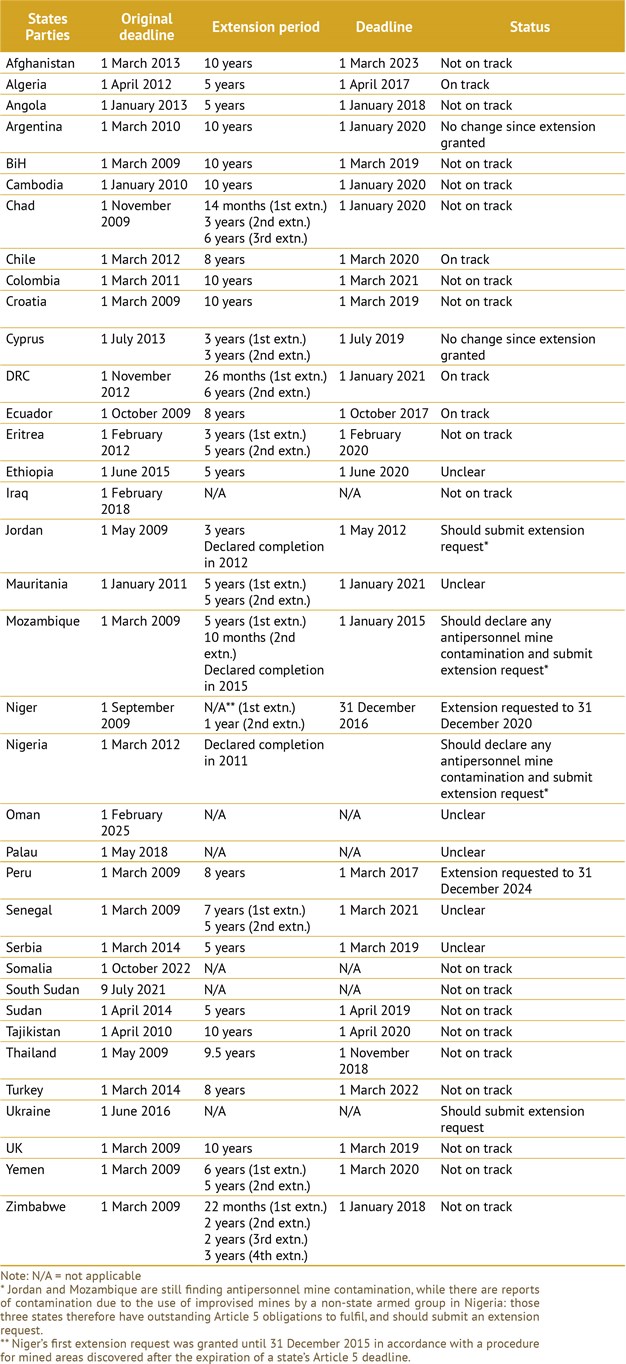
Five States Parties submitted requests for extended deadlines to complete their Article 5 obligations that were granted at the Fourteenth Meeting of the States Parties, in December 2015:
- Cyprus was granted a three-year extension for a remaining contaminated area over which it does not have effective control.[16] This was Cyprus’s second extension.
- Ethiopia requested five years to complete survey and clearance of all remaining mined areas. States Parties expressed “serious concern” that Ethiopia was in non-compliance with Article 5, having missed its 1 June 2015 clearance deadline. In granting the request, States Parties asked Ethiopia to better disaggregate suspected hazardous areas and confirmed hazardous areas, to report annually, and to submit an updated plan by April 2017.[17]
- Mauritania was granted five years because of suspected contamination on its border with the area of Western Sahara, in locations where border demarcation needs to be clarified. States Parties asked Mauritania to provide regular updates on the dialogue with stakeholders aimed at acquiring information about border location.[18] This was Mauritania’s second extension.
- Niger requested five years to complete survey and clearance of all mined areas. However, its request was submitted in November 2015, while the procedure agreed by States Parties required a submission by March 2015. Niger was granted one year and was asked to submit another request by March 2016 in order to allow the necessary time “for a cooperative exchange between the requesting State and the Committee on Article 5 Implementation to take place.”[19] This was Niger’s second extension.
- Senegal was granted five years to complete survey and clearance. In granting the request, States Parties regretted that “a detailed annual work plan for survey and clearance leading to completion and based on accurate and coherent data [was] still missing.” They asked Senegal to report annually and to submit an updated workplan by April 2017, with annual projections and a detailed budget.[20] This was Senegal’s second extension.
The Fourteenth Meeting of States Parties recorded Ukraine’s intention to submit an extension request. It noted that “[t]he official, duly compiled, request would be soon submitted to the States Parties for their consideration.”[21] Ukraine is in violation of Article 5 for missing its 1 June 2016 mine clearance deadline, a situation that was foreseen already in December 2015 when Ukraine expressed its intention to submit an extension request.[22] As of 15 October 2016, Ukraine had still not submitted a request.
In 2016, two States Parties submitted requests for extended deadlines to complete their Article 5 obligations for approval at the Fifteenth Meeting of States Parties in November:
- Niger requested until 31 December 2020 to complete survey and clearance of all mined areas, noting that “without the support of partners, Niger could not guarantee [completion].”[23] The International Campaign to Ban Landmines (ICBL) noted that Niger’s acceptance of an existing offer of support from an international mine clearance organization would contribute to greatly reducing the amount of time necessary.[24]
- Peru requested until 31 December 2024 to complete survey and clearance, noting the difficulties of the terrain and the acquisition of data on additional contaminated areas through information exchanges with Ecuador.[25] The Committee on Article 5 Implementation encouraged Peru to make the best possible use of the amended International Mine Action Standards on land release “to further enhance efficient and expedient implementation.”[26]
Monitoring the progress of States Parties against their Article 5 obligations and the Maputo Action Plan
In the Maputo Action Plan, States Parties agreed to “commit to intensify their efforts to complete their respective time-bound obligations with the urgency that the completion work requires.”[27] Actions 8, 9, and 11 relate to clearance.
The Committee on Article 5 Implementation presented preliminary observations at the Intersessional Meetings on 19-20 May 2016, reporting on 17 States Parties that had submitted information by that date.[28]
This assessment of progress under the Maputo Action Plan is drawn from both the committee’s observations and Landmine Monitor’s review of the progress of States Parties.
Maputo Action Plan #8: quantification and qualification of remaining contamination challenge
Almost all States Parties need to improve the quantification and qualification of the remaining contamination challenge. Eleven States Parties have a good knowledge of the locations of confirmed and suspected contamination but need to clarify the actual extent of contamination within those areas: BiH, Chile, Croatia, Cyprus, Jordan, Peru, Senegal, Serbia, Tajikistan, Thailand, and Turkey. Fifteen States Parties have reported on known contaminated areas, but do not have a complete picture of the extent of contamination, as there are unrecorded areas: Afghanistan, Angola, Cambodia, Chad, Colombia, Eritrea, Ethiopia, Iraq, Mozambique, Niger, Somalia, South Sudan, Sudan, Yemen, and Zimbabwe. Three States Parties have not formally recorded the locations of any mined areas: Nigeria, Oman, and Ukraine. Two States Parties need to verify that they have no remaining mine contamination: Mauritania and Palau. Three States Parties have a very clear understanding of the remaining contamination: DRC, Ecuador, and the UK.[29] Algeria has a good understanding of the extent of contamination but has not provided details of the size and locations.
The committee assessed the degree of clarity of the remaining challenge, finding that only seven of the 17 States Parties assessed had provided a high degree of clarity in their reporting: Afghanistan, Chile, Ecuador, Serbia, Sudan, Thailand, and the UK.
Maputo Action Plan Action #9: application of land release methodologies
Almost all States Parties that implemented systematic mine clearance programs in 2015 used land release methodologies (survey and clearance), although the degree to which they are aligned with International Mine Action Standards (IMAS) varies. The committee called on States Parties to align their national mine action standards with the revised IMAS if they have not already done so.
Maputo Action Plan Action #11: call for on-time submission of high-quality requests
In 2016, two states submitted requests on time (Niger and Peru). Ukraine’s intention to submit a request was recorded at the Fourteenth Meeting of States Parties in December 2015, but the request had still not been submitted as of 15 October 2016. Niger’s request lacks the action plan with annual benchmarks that is essential to any good-quality request. Peru’s revised request can generally be considered of good quality: it contains consistent data and outlines relevant activities with the appropriate bodies in charge of carrying them out.[30] Jordan, Mozambique, and Nigeria should submit an extension request to address the contamination that has been identified after they declared completion of clearance.
Maputo Action Plan Action #25: call for the annual submission of high-quality and updated information
As of 15 October 2016, Article 7 transparency reports for 2015 were still outstanding for 12 states with contamination: Angola, DRC, Eritrea, Ethiopia, Mozambique, Niger, Nigeria, Palau, Serbia, Somalia, Tajikistan, and Yemen.
Other issues affecting clearance operations
Funding
Mine action experienced a severe reduction in funding in 2015, negatively affecting land release results. Inadequate funding was cited as a challenge to achieving Article 5 implementation deadlines by the following States Parties: Afghanistan,[31] Angola,[32] Cambodia,[33] Chad,[34] Ethiopia,[35] Eritrea,[36] Iraq, [37] Niger,[38] Senegal,[39] and Yemen.[40] In Afghanistan, the amount of land released in 2015 almost halved from the previous year, due to the downturn in funding.[41] In South Sudan, despite the fact that 2015 was one of the most productive years for land release, operators expressed concern over decreased funding for mine action in 2015, with donors prioritizing other humanitarian sectors or refusing to fund mine action activities while the conflict is ongoing.[42] Although DRC[43] and Serbia[44] can achieve their Article 5 deadlines, both States Parties reported funding difficulties. In BiH, it was reported that the slow pace of clearance had resulted in a lack of confidence in the mine action program from donors.[45]
National ownership
Almost all Mine Ban Treaty States Parties with contamination have national mine action programs or institutions that are assigned to fulfil the state’s clearance obligations. Palau, Turkey, and Ukraine are in the process of establishing mine action programs. In Nigeria, explosive ordnance disposal is conducted by the army and police.
In contrast, fewer than half of the states not party have functioning mine action programs.[46] The following 11 states not party do not have mine action programs: China, Cuba, Kyrgyzstan, Morocco, Myanmar, North Korea, Pakistan, Russia, South Korea, Syria, and Uzbekistan. In India, the army decides on clearance based on reports from district commanders. Egypt’s mine action program is not functional and the status of Iran’s mine action center is not clear. The understanding of the extent of contamination, and the scale of land release efforts, is much lower in states not party than in States Parties. This underlines the importance of striving for universalization of the Mine Ban Treaty, in order to address the threat posed by antipersonnel mines.
Clearance in conflict
In 2015 and 2016, conflict affected land release operations in nine States Parties (Afghanistan, Colombia, Iraq, Nigeria, Somalia, South Sudan, Sudan, Ukraine, and Yemen) and five states not party (Libya, Myanmar, Pakistan, Palestine, and Syria.)
In 2015, eight personnel from the Mine Action Program of Afghanistan were killed and 34 injured in security incidents, and 63 were abducted and then released.[47] In South Sudan, two Danish Demining Group (DDG) staff were killed by gunmen.[48]
Insecurity has also restricted access to some antipersonnel mine-affected areas in Ethiopia, Jordan, Senegal, and Turkey.[49]
Cyprus does not have effective control of antipersonnel mine-contaminated areas.[50] In Palestine, Israel will not authorize clearance by Palestinians, and most mined areas are in zones controlled by Israel or under joint control.[51] Ukraine has noted that it does not currently have access to some mined areas.[52]
In Colombia, the peace process between the government and the Revolutionary Armed Forces of Colombia (Fuerzas Armadas Revolucionarias de Colombia, FARC) gave momentum to demining planning in 2015. However, it remains to be seen what will happen after a plebiscite rejected the September 2016 Peace Agreement.
In Myanmar, the government said that concluding a National Ceasefire Agreement with non-state actors was a precondition for proceeding with survey and clearance.[53]
[1] The Monitor gratefully acknowledges the contributions of the Mine Action Review supported and published by Norwegian People’s Aid (NPA), which conducted mine action research in 2016 and shared it with the Monitor. The Monitor is responsible for the findings presented online and in its print publications.
[2] In addition, El Salvador completed clearance in 1994, before the Mine Ban Treaty was created. Three states (Jordan, Nigeria, and Mozambique) that had declared completion in the past are still finding antipersonnel mine contamination, including, in some cases, victim-activated improvised mines (Nigeria)—they are not included in the total figure of 26 States Parties.
[3] Email to the Palau Authorities from Steve Ballinger, Operations Director, General Demining Command (CGD), 1 December 2015.
[4] For further details of the estimated extent of antipersonnel mine contamination, see the Mine Action country profiles at www.the-monitor.org/cp.
[5] Various media outlets have reported “landmine” use by Boko Haram militants. Cameroon should publicly address these reports, and immediately inform States Parties of any newly discovered antipersonnel mine contamination.
[6] Djibouti completed its clearance of known mined areas in 2003 and France declared it had cleared a military ammunition storage area in Djibouti in November 2008, but there are concerns that there may be mine contamination along the Eritrean border following a border conflict in June 2008. Djibouti has not made a formal declaration of full compliance with its Article 5 obligations.
[7] Moldova, which had an Article 5 deadline of 1 March 2011, made a statement in June 2008 that suggested it had acknowledged its legal responsibility for clearance of any mined areas in the breakaway republic of Transnistria, where it continues to assert its jurisdiction. However, this statement was later disavowed by the Ministry of Foreign Affairs, bit.ly/MoldovaNSA2008.
[8] Despite a statement by Namibia made at the Second Review Conference that it was in full compliance with Article 5, questions remain as to whether there are mined areas in the north of the country, for example, in the Caprivi region bordering Angola.
[9] The Philippines, which has alleged use of antipersonnel mines by non-state armed groups over recent years, has not formally reported the presence of mined areas.
[10] There have been casualties from victim-activated improvised explosive devices in Tunisia in 2015 and 2016. Due to the ongoing nature of the conflict, it is likely that these devices were recently laid.
[11] Mine Ban Treaty Article 7 Report (for 2015), Form G.
[12] Antipersonnel mines were destroyed during spot clearance only.
[13] Declaration of completion of implementation of Article 5 of the Convention on the Prohibition of the Use, Production, Stockpiling and Transfer of Anti-Personnel Mines and on Their Destruction, APLC/MSP.12/2012/Misc.3, Geneva, 4 December 2012.
[14] Declaration of completion of implementation of Article 5 of the Convention on the Prohibition of the Use, Production, Stockpiling and Transfer of Anti-Personnel Mines and on Their Destruction, APLC/MSP.14/2015/MISC.2, Geneva, 16 December 2015.
[15] Statement of Nigeria, Mine Ban Treaty Eleventh Meeting of States Parties, Phnom Penh, 29 November 2011.
[16] Final Report, Mine Ban Treaty Fourteenth Meeting of States Parties, 15 December 2015, p. 5.
[17] Ibid., pp. 5–6.
[18] Ibid., p. 7.
[19] Ibid.
[20] Ibid., p. 8.
[21] Ibid., p. 9.
[22] Ibid.
[23] Mine Ban Treaty Article 5 deadline Extension Request, dated 15 March 2016, submitted on 15 April 2016, p. 13.
[24] Statement of the ICBL on Niger’s Extension Request, Mine Ban Treaty Intersessional Meetings, Geneva, 19 May 2016.
[25] Mine Ban Treaty Article 5 deadline Extension Request (Revised), dated July 2016, submitted on 2 August 2016.
[26] Preliminary Observations, Committee on Article 5 Implementation, Mine Ban Treaty Intersessional Meetings, Geneva, 19–20 May 2016.
[27] Maputo Action Plan, 27 June 2014, bit.ly/MaputoActionPlan.
[28] Preliminary Observations of the Committee on Article 5 Implementation, 23 June 2015, bit.ly/MBTArt5Prelim2015. States Parties reported on are Afghanistan, Algeria, BiH, Cambodia, Chad, Chile, Cyprus, Ecuador, Mauritania, Niger, Peru, Serbia, Sudan, Thailand, the UK, Yemen, and Zimbabwe.
[29] Argentina and the UK both claim sovereignty over the Falkland Islands/Malvinas, which still contain mined areas.
[30] See details in Niger and Peru’s respective country profiles at www.the-monitor.org/cp.
[31] Email from the Mine Action Coordination Centre for Afghanistan (MACCA), 1 May 2016.
[32] Statement of Angola, Mine Ban Treaty Intersessional Meetings (Committee on Article 5 Implementation), Geneva, 19 May 2016; and “CNIDAH says the complete elimination of mines and remnants of war will take a long time,” Agencia Angola Press (ANGOP), 13 March 2015.
[33] “Concept Paper: Cambodian Mine Action Resources Mobilisation,” Cambodian Mine Action and Victim Assistance Authority (CMAA), undated but 2016.
[34] Chad, Third Article 5 deadline Extension Request, 2 May 2013; email from Julien Kempeneers, Handicap International (HI), 2 May 2016.
[35] Ethiopia, Article 5 deadline Extension Request, 31 March 2015, pp. 40–41.
[36] Statement of Eritrea, Mine Ban Treaty Thirteenth Meeting of States Parties, Geneva, 6 December 2013.
[37] Email from Ahmed Al Jasim, Directorate of Mine Action (DMA), 22 May 2016.
[38] Article 5 deadline Extension Request, 1 July 2013; Executive summary of Niger’s Second Article 5 deadline Extension Request, 27 November 2015, p. 2; and Revised Second Article 5 deadline Extension Request, 15 March 2016, p. 14.
[39] Senegal, Second Article 5 deadline Extension Request, June 2015, p. 22.
[40] Yemen, Second Article 5 deadline Extension Request, 17 December 2013, p. 15.
[41] Email from MACCA, 1 May 2016.
[42] Responses to questionnaire by Ismael Frioud, Mines Advisory Group (MAG), 9 April 2015; from Augustino Seja, Norwegian People’s Aid (NPA), 2 June 2015; and from Rickard Hartmann, Danish Demining Group (DDG), 22 May 2015.
[43] Statement of DRC, Mine Ban Treaty Intersessional Meetings (Committee on Article 5 Implementation), Geneva, 25 June 2015.
[44] Preliminary observations of the Mine Ban Treaty Committee on Article 5 Implementation, Intersessional Meetings, Geneva, 19–20 May 2016; statements of Serbia, Mine Ban Treaty Fourteenth Meeting of States Parties, Geneva, 1 December 2015; and Mine Ban Treaty Intersessional Meetings (Committee on Article 5 Implementation), Geneva, 19 May 2016.
[45] UNDP, Draft Mine Action Governance and Management Assessment for BiH, 13 May 2015, p. 14.
[46] Armenia, Azerbaijan, Georgia, Israel, Lao PDR, Lebanon, Libya, Palestine, Sri Lanka, Vietnam.
[47] Email from the MACCA, 1 May 2016.
[48] Danish Refugee Council, “Two national employees have lost their lives in South Sudan,” 12 April 2016, http://reliefweb.int/report/south-sudan/two-national-employees-have-lost-their-lives-south-sudan.
[49] “Response to Committee on Article 5 Implementation request for additional information on its Article 5 deadline Extension Request,” submitted 26 September 2015; Analysis of Ethiopia’s Article 5 deadline Extension Request, 19 November 2015, p. 3; Jordan’s Article 5 Declaration of Completion 2012; email from Mohammad Breikat, National Committee for Demining and Rehabilitation (NCDR), 25 August 2016; Senegal, Article 5 deadline Extension Request, 20 June 2015; and Turkey, Mine Ban Treaty Article 7 Report (for 2015), Form C.
[50] Final Report, Mine Ban Treaty Fourteenth Meeting of States Parties, 15 December 2015, p. 5
[51] Email from the Planning Department, Palestine Mine Action Centre (PMAC), 9 May 2016.
[52] Final Report, Mine Ban Treaty Fourteenth Meeting of States Parties, 15 December 2015, p. 9.
[53] Roger Fasth and Pascal Simon, “Mine Action in Myanmar,” Journal of Mine Action, Issue 19.2, July 2015.

